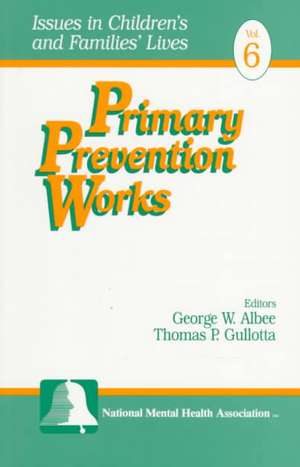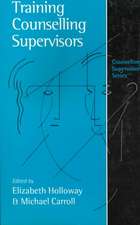Primary Prevention Works: Issues in Children's and Families' Lives, cartea 6
Autor George W. Albee, Thomas P. Gullottaen Limba Engleză Paperback – 18 feb 1997
| Toate formatele și edițiile | Preț | Express |
|---|---|---|
| Paperback (1) | 727.31 lei 6-8 săpt. | |
| SAGE Publications – 18 feb 1997 | 727.31 lei 6-8 săpt. | |
| Hardback (1) | 1005.75 lei 6-8 săpt. | |
| SAGE Publications – 18 feb 1997 | 1005.75 lei 6-8 săpt. |
Din seria Issues in Children's and Families' Lives
- 18%
 Preț: 1113.71 lei
Preț: 1113.71 lei - 15%
 Preț: 643.34 lei
Preț: 643.34 lei - 15%
 Preț: 641.53 lei
Preț: 641.53 lei - 18%
 Preț: 935.98 lei
Preț: 935.98 lei - 15%
 Preț: 645.47 lei
Preț: 645.47 lei - 18%
 Preț: 1208.00 lei
Preț: 1208.00 lei -
 Preț: 389.31 lei
Preț: 389.31 lei - 15%
 Preț: 612.71 lei
Preț: 612.71 lei - 15%
 Preț: 555.44 lei
Preț: 555.44 lei -
 Preț: 385.84 lei
Preț: 385.84 lei - 18%
 Preț: 720.35 lei
Preț: 720.35 lei - 15%
 Preț: 655.60 lei
Preț: 655.60 lei - 5%
 Preț: 1283.89 lei
Preț: 1283.89 lei - 15%
 Preț: 614.67 lei
Preț: 614.67 lei -
 Preț: 392.97 lei
Preț: 392.97 lei - 5%
 Preț: 833.62 lei
Preț: 833.62 lei - 18%
 Preț: 958.07 lei
Preț: 958.07 lei - 18%
 Preț: 793.51 lei
Preț: 793.51 lei - 5%
 Preț: 847.37 lei
Preț: 847.37 lei - 15%
 Preț: 575.22 lei
Preț: 575.22 lei - 18%
 Preț: 851.84 lei
Preț: 851.84 lei - 5%
 Preț: 621.87 lei
Preț: 621.87 lei - 18%
 Preț: 952.09 lei
Preț: 952.09 lei - 5%
 Preț: 622.06 lei
Preț: 622.06 lei - 18%
 Preț: 1106.89 lei
Preț: 1106.89 lei
Preț: 727.31 lei
Preț vechi: 886.97 lei
-18% Nou
Puncte Express: 1091
Preț estimativ în valută:
139.17€ • 145.69$ • 115.15£
139.17€ • 145.69$ • 115.15£
Carte tipărită la comandă
Livrare economică 07-21 aprilie
Preluare comenzi: 021 569.72.76
Specificații
ISBN-13: 9780761904687
ISBN-10: 0761904689
Pagini: 440
Dimensiuni: 140 x 216 x 29 mm
Greutate: 0.59 kg
Ediția:New.
Editura: SAGE Publications
Colecția Sage Publications, Inc
Seria Issues in Children's and Families' Lives
Locul publicării:Thousand Oaks, United States
ISBN-10: 0761904689
Pagini: 440
Dimensiuni: 140 x 216 x 29 mm
Greutate: 0.59 kg
Ediția:New.
Editura: SAGE Publications
Colecția Sage Publications, Inc
Seria Issues in Children's and Families' Lives
Locul publicării:Thousand Oaks, United States
Cuprins
Preface - Rosalynn Carter
The Importance of Prevention
Introduction
PART ONE: THE PRINCIPLES OF PREVENTION
Primary Prevention's Evolution - George W Albee and Thomas P Gullotta
Operationalizing Albee's Incidence Formula - Thomas P Gullotta
PART TWO: INFANT AND TODDLER PROGRAMS
The Prenatal/Early Infancy Project - David Olds
Fifteen Years Later
Early Intervention for High-Risk Families - Grace-Ann Caruso Whitney
Reflecting on a 20-Year-Old Model
Infant-Family Resource Program - Elsie R Broussard
PART THREE: PRESCHOOL PROGRAMS
Parents as Teachers - Mildred M Winter and Danica S McDonald
Investing in Good Beginnings for Children
High/Scope Perry Preschool Program - David P Weikart and Lawrence J Schweinhart
Interpersonal Cognitive Problem-Solving - Myrna B Shure
Primary Prevention of Early High-Risk Behaviors in the Preschool and Primary Years
PART FOUR: SCHOOL-AGE PROGRAMS
Primary Mental Health Project - A Dirk Hightower
The Children of Divorce Intervention Program - JoAnne Pedro-Carroll
Fostering Resilient Outcomes for School-Aged Children
Improving Social Awareness-Social Problem Solving Project - Linda Bruene-Butler et al
The Social-Competence Promotion Program for Young Adolescents - Roger P Weissberg, Heather A Barton and Timothy P Shriver
Going for the Goal - Steve J Danish
A Life Skills Program for Adolescents
Teen Education and Employment Network - Laurie J Bauman et al
PART FIVE: ADULT PROGRAMS
From Job Loss to Reemployment - Robert D Caplan, Amiram D Vinokur and Richard H Price
Field Experiments in Prevention-Focused Coping
The San Francisco Depression Prevention Research Project - Ricardo F Muñoz
Epilogue - Michael M Faenza and Sandra J McElhaney
Reframing Prevention Advocacy and Looking Ahead
The Importance of Prevention
Introduction
PART ONE: THE PRINCIPLES OF PREVENTION
Primary Prevention's Evolution - George W Albee and Thomas P Gullotta
Operationalizing Albee's Incidence Formula - Thomas P Gullotta
PART TWO: INFANT AND TODDLER PROGRAMS
The Prenatal/Early Infancy Project - David Olds
Fifteen Years Later
Early Intervention for High-Risk Families - Grace-Ann Caruso Whitney
Reflecting on a 20-Year-Old Model
Infant-Family Resource Program - Elsie R Broussard
PART THREE: PRESCHOOL PROGRAMS
Parents as Teachers - Mildred M Winter and Danica S McDonald
Investing in Good Beginnings for Children
High/Scope Perry Preschool Program - David P Weikart and Lawrence J Schweinhart
Interpersonal Cognitive Problem-Solving - Myrna B Shure
Primary Prevention of Early High-Risk Behaviors in the Preschool and Primary Years
PART FOUR: SCHOOL-AGE PROGRAMS
Primary Mental Health Project - A Dirk Hightower
The Children of Divorce Intervention Program - JoAnne Pedro-Carroll
Fostering Resilient Outcomes for School-Aged Children
Improving Social Awareness-Social Problem Solving Project - Linda Bruene-Butler et al
The Social-Competence Promotion Program for Young Adolescents - Roger P Weissberg, Heather A Barton and Timothy P Shriver
Going for the Goal - Steve J Danish
A Life Skills Program for Adolescents
Teen Education and Employment Network - Laurie J Bauman et al
PART FIVE: ADULT PROGRAMS
From Job Loss to Reemployment - Robert D Caplan, Amiram D Vinokur and Richard H Price
Field Experiments in Prevention-Focused Coping
The San Francisco Depression Prevention Research Project - Ricardo F Muñoz
Epilogue - Michael M Faenza and Sandra J McElhaney
Reframing Prevention Advocacy and Looking Ahead
Notă biografică
Descriere
Mental disorders cost the United States over $72 billion for treatment, related support and lost productivity each year - yet funding for prevention of such disorders has been inconsistent due, partly, to lack of confidence in the effectiveness of specific prevention programmes. This book highlights some of the most effective prevention programmes and offers a common set of principles to reduce maladaptive behaviour.
Following an overview of United States prevention history and a description of how to operationalize George Albee's incidence formula, contributors then focus on: programmes that increase parent-child interaction and parenting ability; preschool programmes, such as those which use parents as teachers, others wh















